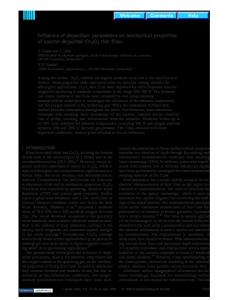Influence of spray-pyrolysis deposition parameters on the electrical properties of aluminium zinc oxides thin films
- PDF / 1,089,397 Bytes
- 7 Pages / 432 x 648 pts Page_size
- 7 Downloads / 387 Views
MRS Advances © 2018 Materials Research Society DOI: 10.1557/adv.2018.121
Influence of spray-pyrolysis deposition parameters on the electrical properties of aluminium zinc oxides thin films Denis E. Martins1, Giovani Gozzi1 and Lucas Fugikawa Santos1,2 1
Departamento de Física, Universidade Estadual Paulista - UNESP, Avenida 24A, 1515, CEP: 13500970,Rio Claro, SP, Brazil.
2 Departamento de Física, Universidade Estadual Paulista - UNESP, Rua Cristovao Colombo 2265, CEP 15054-000, São José do Rio Preto, SP, Brazil.
In the current work, we evaluate the influence of the processing parameters on the electrical properties of aluminium zinc oxide (AZO) thin films produced by airbrush spray-pyrolysis deposition technique. Spray-deposited AZO thin-films were produced with Al:Zn molar ratios varying from 0 % (pure ZnO) up to 30 %, using aluminium acetate and zinc acetate as organic precursors and water as solvent. Thermogravimetric analysis (TGA) and infrared spectroscopy (FTIR-ATR) were used to monitor the metal-oxide formation from the organic precursors as a function of the temperature. The results show that a temperature of 400 °C is necessary to completely degrade the organic phase and to obtain the desired inorganic metaloxides films. The electrical properties of the TMOs were evaluated by d.c. current-voltage (IV) analysis using planar thermally evaporated Al electrodes on top of the TMO layer, with different aspect ratios (1/18, 2/9, 5/13, 5/9 and 8/9). The lowest sheet resistance was obtained for AZO films at a molar Al concentration of 5 %. We also observed that, after carrying out a post-annealing treatment (30 mbar, 150 °C) the samples presented a decrease on the sheet resistance superior to 60 %, in comparison to the samples before the treatment.
Introduction: Transparent metal oxides (TMOs) are semiconducting/conducting materials which have been regularly investigated in the past few years due to their interesting properties as the active semiconducting layer of electronic devices (such as thin-film transistors, TFTs) or as transparent conductive layer of optoelectronic devices as organic light-emitting diodes and solar cells. For most of these applications, TMOs thin-films are usually deposited by sophisticated techniques like RF sputtering or pulsed-laser deposition (PLD), which result in highly homogeneous and uniform films, with high optical transmittance and high electrical conductivity [1,2]. However, the increasing demand for large scale production of devices with large areas has stimulated the pursuit for new, low-cost, alternative deposition techniques. In this sense, spray-pyrolysis (SP) is a simple, versatile, efficient and low-cost deposition method [3], which easily permits the upscaling to produce large-area devices. The electrical and optical properties of TMOs films produced by SP, however, are strongly affected by processing parameters, such as deposition temperature, post-processing annealing and the metal oxide composition.
Downloaded from https://www.cambridge.org/core. Monash Universi
Data Loading...











